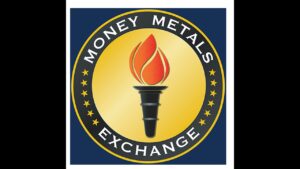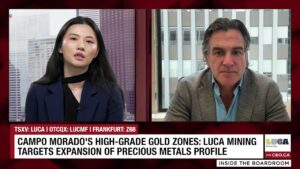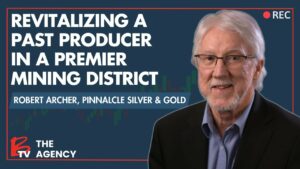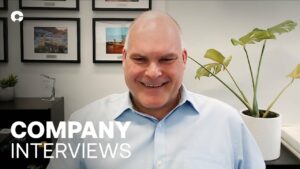Executives
Jason D. Reid – Chief Executive Officer, President and Director
Joe Rodriguez – Chief Financial Officer and Corporate Controller
William W. Reid – Co-Founder and Chairman
Analysts
Charlie Fitzgerald
Gold Resource Corp (GORO) Q3 2013 Earnings Call November 8, 2013 1:00 PM ET
Operator
Thank you for joining Gold Resource Corporation’s Third Quarter Earnings Conference Call. Mr. Jason Reid, CEO, will be hosting today’s call. Following Mr. Reed’s opening remarks, there will be a question and answer period. As a reminder, today’s call is being recorded and will posted to the company’s website within 3 to 5 business days.
Please go ahead, Mr. Reid.
Jason D. Reid – Chief Executive Officer, President and DirectorThank you. Good morning, and thank you for joining Gold Resource Corporation’s third quarter conference call. I’m pleased to address you today as CEO and President. And as you will see in my comments during the conference call, the course that was set for the company by Bill, Dave and me in 2006, when Gold Resource Corporation was a private company, is the same course I will chart going forward. I will continue to focus on building shareholder value, return on capital and return on investment to include dividends as we grow the company, not by growth-for-growth sake but smart growth for value creation during this volatile precious metals market.
Joining me on the call today for the Q&A portion would be Chairman of the Board, Mr. Bill Reid, and Mr. Joe Rodriguez, our new Chief Financial Officer.
Before we get started, let me remind everyone that certain statements made on this call are not historical facts and are considered forward-looking statements. These statements are subject to numerous risks and uncertainties as described in our Annual Report on Form 10-K and other SEC filings, which could cause our actual results to differ materially from those expressed in or implied by our comments. Forward-looking statements in the earnings that we issued yesterday, along with comments on this call, are made only as of today, November 8, 2013, and we undertake no obligation to publicly update any of those forward-looking statements as actual events unfold.
You can find reconciliation of non-GAAP financial measures referred to in our remarks in our third quarter Form 10-Q just filed with the SEC for the quarter ended September 30, 2013.
For the third quarter of 2013, our mill production was 21,244 ounces of precious metal gold equivalent increasing production totals to approximately 64,148 ounces for the first three quarters, which is in line with our 2013 annual target of 80,000 to 100,000 precious metal gold equivalent ounces. This target may change in the future depending on items including mine development and mill upgrade expansion construction. We are attempting to minimize mill shutdown days during the construction process, but there is no assurance that it won’t impact our production for the year.
Our team at the El Aguila Project, led by our Chief Operating Officer, Rick Irvine, and our General Manager, Mr. Jesus Rivera, are doing a great job. These professionals continue to achieve production results in line with the company’s stated year end goals. On track production is no small achievement in the midst of significant engineering and no construction taking place at the El Aguila Project, and the weaker silver-to-gold ratio during 2013. And we have had several questions related to this silver-to-gold ratio, and this is a market metal price ratio, not a ratio referring to the metals in our Arista mine.
We are closing in on mill expansion completion, which I will go into later on during the call. We sold 19,033 ounces gold equivalent at total cash cost of $756 per equivalent ounce. We generated revenues — remember our revenues are net of smelter charges of $29.4 million and had mine gross profit of $11.4 million. Our average metal price realized for gold was $1,240 per ounce, and for silver, was $19 per ounce.
I want to take a minute and go over 2 topics that are cause for questions as it relates to the aforementioned ounces sold and average metal prices realized. As for ounces sold and produced, relating to inventory, our mill production ounces and our ounces sold are not the same and will not be the same when we are selling concentrates. Mill production is straightforward and that is the estimate of what the mill actually produces in the form of concentrates and is what we ship to the buyer. However, based on U.S. GAAP, our sales of concentrates are net or after smelter charges. So the ounces sold may be less than the ounces produced due to being unable to ship all our finished concentrates in our inventory stockpile.
In other events, the ounces produced maybe less than the ounces sold due to finished concentrate inventory carried over from the previous periods. As for ounces sold and produced relating to revenue, we deliver 100% of our concentrates to the buyer, but will only be paid approximately 90% due to the payable metal deductions from the buyer.
Our footnotes 3 and 4 in the MD&A below, production and sales statistics table, further clarified this common question. Now, as for average metal prices realized in our statistics table in the MD&A, the operative word is realized price. These prices are not exclusively related to current spot market metal prices. For instance, our realized silver price for Q3 was $19 per ounce. The reason for this goes back to the fact that we are selling concentrates on a provisional basis and the fact that our concentrate contracts provide for final settlements on a future date.
We are paid a provisional invoice at the time of delivery from the buyer based on estimated pricing and assays. The final invoice and settlement price will be set based on the average monthly spot price for the month following delivery. We refer to it as M+1, and the final assays. Invoices do not always settle within the M+1 quotational period due to certain provisional invoices going into the Empire or third parties. The net effect of this is as follows: If we were paid under the provisional invoice where the provisional assay results were higher than the final assays, we must deduct that overpayment from the current settlement price, or in other words, payback the concentrate buyer for the differences or overpayment. This mathematically lowers the realized sales price. This may work against us in downward moving spot metal price markets, but may work in our favor in upward moving spot metal prices.
So the final settlement adjustments realized metal price will not mirror market spot prices due to in period and out of period settlement adjustments for pricing, weight and assay factors when closing these final invoices.
Moving on. The company continue to pay its monthly $0.03 per share dividend totaling $4.5 million during the third quarter. Our long-term goal is distributing an approximate 1/3 ratio of our cash flow from mine site operations remains in tact, though the ratio will vary from time to time and based on multiple factors. The 8% royalty to be imposed on precious metal producers by the Mexican government will also need to be factored into our dividend equation going forward in 2014. However, it will take some time to determine exactly what effect that impact of this new royalty will be.
It is unfortunate Mexico will lose its status as one of the friendliest mining jurisdictions in Latin America, January 1, 2014, when the new royalty may begin to take effect. Already, articles mentioned 200 Canadian junior explorers canceling programs and claims in Mexico. This is not the first time Mexico has instituted royalties on mining. Scotiabank noted that in 1980, a royalty imposed by the Mexican government on mining was canceled 1 year after it was enacted. Few doubt that less mining capital would be put to work in Mexico in response to the new royalty, and that includes Gold Resource Corporation. In the future, we will focus far more attention and effort toward projects located outside of Mexico.
Turning back to the financials. We showed a net loss for the quarter of $1.4 million or $0.03 per share though we showed net income of $4.2 million or $0.08 per share for the 9 months. Remember, as an exploration stage company, as we are defined by the SEC, for accounting purposes, we must expense all construction and development costs. Including our mill expansion capital expense this year, which is part of the reason for the quarterly loss. Because we cannot capitalize our construction and development costs, we tend to show lesser profits for the period than similar producing companies who can capitalize their construction and development expenditures.
With a net loss for the quarter of $1.4 million, but with the facility development expense of $5.7 million, had those expenses been capitalized and adding some depreciation expense, we would have shown a profit for the quarter. This facilities development expense include our mill expansion and mine construction.
Tonnes milled per day averaged 913 for the quarter, with the following average head grades and recoveries: Gold, 3.67 grams per tonne, with an 88% recovery; silver, 321 grams per tonne, with a 94% recovery; copper, 0.38%, with a 75% recovery; lead, 1.09%, with a 64% recovery; and zinc, 2.73%, with an 80% recovery.
We continue to incur a higher operating cost during the quarter, as we have yet to see the benefit of the new mill’s future higher rate of production, though we are sustaining now all the fixed cost associated with the increased production plans. We expect to see the cost per ounce and per tonne go down in the future as the tonnage rate through the mill goes up. In addition, like most all other mining companies, we are looking at places where we can reduce our overall costs.
Specific cost-cutting measures were taken during the third quarter, which we expect to be reflected in lower production costs and in conservation of cash early 2014. Third quarter cost reduction measures included a manpower reduction of 60 employees or 13%; the winding down of our mill expansion’s Engineering, Procurement, Construction Management, or our EPCM, by the engineering firm, Lyntek, that assisted us in the mill expansion, and by diesel fuel efficiencies, including our new 10-megawatt diesel generated power plant commissioned at the end of the quarter.
Many of these cost-cutting measures during the quarter were not reflected in third quarter costs, like the manpower reduction for instance. Where a legal severance due under Mexican labor law to determinate an employee for approximately $400,000, which temporarily offset the approximate $200,000 per month cost savings that is estimated to impact the fourth quarter and beyond.
In an effort to assure mill expansion delivery by year end, we had more employees possibly than necessary, and air on the side of caution. Since employees are one of our biggest costs and with the construction expansion winding down, we made the decision to reduce cost by the recent manpower reduction to better streamline operations. We continue to evaluate additional potential cost-cutting measures on the operations side and coupled with the expected future increases to mill throughputs, my goal is to substantially drive down our cost per ounce and per tonne by early to mid-2014. With the expected cost savings previously mentioned and planned cost reduction in the future, coupled with our mill expansion being nearly complete, we believe we will be in the position to once again add cash back to our bank accounts.
It is important to note that the mill expansion has been achieved with our cash flow. With successful mill construction completion this year, we expect a much lower CapEx in 2014, compared to 2013, to rebuild our Treasury.
We are pleased with mill construction advancements. And as of today, we are on target for a mill expansion delivery by year end that can process a nominal 1,500 tonnes per day going through into 2014.
To be clear, we do not expect to be feeding the mill at a maximum 1,500 tonnes per day rate early next year, but expect to ramp up tonnages as mine development allows. The ability to process 1,500 tonnes per day will be important for our future growth curve and our reduction of costs.
We announced earlier this week the commissioning of the floatation circuit’s second ball mill, along with the commissioning of our 10-megawatt diesel generated power plant. We expect to reduce our diesel power cost, our second largest expense by 15%, as a result of efficiency improvements and better power management. We are excited to wrap up construction activity these next several weeks with the commissioning of the new flotation cells. This is a very exciting time for the company and our operations as we close in on the commissioning of our new expanded El Aguila mill.
With the expanded mill’s ability to process up to 1,500 tonnes per day, we positioned the company for increased future production and our focus now turns to the continued development of our Arista underground mine in preparation for pulling increased tonnage to feed our expandable — expanded new mill.
We currently have 14 working spaces. The primary decline ramp is 45 meters from reaching level 17 and the development work on level 16 recently cut mineralization in the Baja vein. The company has made a substantial investment developing the Arista underground mine for long-haul open stoping, which is the key to increasing tonnage and lowering our per tonne cost goals going forward. We currently stoped between 18-meter levels and 30 meters between rib pillars. We are using concrete and waste rock backfill to extract the valuable rib pillars. Working off a previously completed SRK engineering analysis, we are running tests to validate the potential where rock competency allows of 60 meters stope distances between rib pillars as opposed to the current 30 meters to further optimize our stoping and/or extraction methods when able. Cut-and-fill mining method is being used as well on the smaller veins.
Arista mine development has now identified 10 veins and splays in the deposit. We have identified at least 4 more potentials splays that we expect to become veins with further exploration as well. The Arista mine is far more robust than the initial mining of our 2 primary veins, the Arista and Baja. This is why we continue to be so excited about the potential future expansion of this deposit.
These epithermal systems need complex structure and good ground preparation for the vein swarms to continue. We have both, and our Arista system is still open on strike and depth, with the 10 veins providing opportunities for multiple working phases for current and future mining. We feel we’re at the tip of the iceberg here at our Arista deposit. Arista mineralization now extends over 1,500 meters on strike, which is 3x the initial strike linked that we started with, and over 600 meters of depth extent and is still going.
Our El Aguila project has over 2 kilometers of mineralized structure, and our Oaxaca mining unit, in general, with its 48 kilometers of mineralized structural corridors, speaks to our overall expansion potential. With so many drill targets to test, it is easy to become distracted, but we have made a concerted effort to focus our exploration efforts for now on Arista and the immediate surrounding area.
I’m particularly excited about our discovery of the area we call the Switchback. It is located approximately 500 meters to the northeast of the Arista vein system. Several Switchback drill holes have been lost due to the horizontal angle, distance being drilled and faulting. To counter this, discussions included drifting several hundred meters to set up a drill station. However, Mr. Barry Devlin, our VP of Exploration, managed to obtain a more powerful drill better suited for this particular task, and we now plan to continue to drill the Switchback discovery from current underground Arista mine workings, saving us valuable time and money on exploration drifting right now. And a few more step out drill hole — if a few more step out drill holes into the Switchback returned positive results like the first holes that reached the target, including hole #513082’s 15-meter mineralized vein, including 2.2 meters of 12.91 grams per tonne gold and 410 grams per tonne silver, the justification for spending the time and expense of the drifting to that area will be easy. And we plan to move forward accordingly. We believe the Switchback area is either an extension of the Arista vein system or possibly, a new significant parallel system approximately 5 meters away. Either way, the Switchback, coupled with the potential extensions of known Arista vein deposits, could significantly impact our resource expansion. We plan to find out soon as the new drill was positioned last Thursday with the goal of reaching the Switchback target, again, with at least 2 holes planned by the year end, provided ground conditions and drill contractor execution reach the target.
Turning to corporate matters during the third quarter. As mining companies have cut or discontinued their dividends during these volatile markets, we continued to pay our current $0.03 per share per month dividend during the quarter, and the dividend announced Tuesday of last week marks our 40th consecutive dividend and over $90 million distributed back to our shareholders. Not an easy task, especially in the current metals market and with 2013 mill expansion, but we remained committed to dividend distributions when possible. We made no guarantees of future dividend distributions, but have a solid track record demonstrating our commitment.
To summarize the third quarter, production is on target after 3 full quarters for our year end 2013 production range set at 80,000 to 100,000 ounces precious metal gold equivalent. Our mill expansion construction is on target to be delivered at a nominal process rate of 1,500 tonnes per day capability going into 2014. Mine development continues with multiple working phases, and our exploration and modeling now incorporate 10 veins, not just the 2 primary veins we began mining with. And we have indications of several additional veins as well.
We continue to distribute our $0.03 per share per month dividend, which we think says volumes about the company’s philosophy and performance, a topic I want to further explore near the end of this call.
The third quarter 2013 was a solid quarter for the company. So why the negative stock performance? First, this is a very difficult time for investors in mining stocks as this sector of the market is dramatically out of favor. Most gold-mining stocks are down plus or minus 50% to 60% or more from the first of the year. Sentiment for mining equities is as low or perhaps lower than it was in 2008. CNBC published an article on Sunday, October 27, entitled Gold May Stumble Toward $1,400. The spot gold price was around $1,340 at the time. It’s not uncommon for the mass media to downplay gold, but when a forecasted rise in the gold prices described as a stumble, it is easy to see the negative sentiment towards the gold space. What I believe is missing are the reasons to own gold and silver are more prevalent today than they were a year or 2 ago, but you don’t hear that from the mainstream media. But that’s another topic for another day. The stock market, however, presuming no market manipulation, is a market responding to supply and demand. In other words, when there’s more buyers than sellers, the stock goes up to reflect the demand. If there are more sellers than buyers, the stock goes down to reflect the supply. What one expects or at least hopes is that the supply and demand is a function of performance of the company. Unfortunately, that is not always the case and there are times in the market where disconnect is present. We certainly believe disconnect with Gold Resource Corporation stock price is present right now for the following reasons: First, in a very weak metals market that has already dragged down the mining industry and equities, GORO’s cell side supply increased September 13th when a subscription-based newsletter writer put a sell recommendation on GORO to its paid subscribers, which led to rapid decline and a few dollars in the stock price as it’s subscribers sold out.
Other notable companies that were dropped from its top 10 include Gold Corp. and Silver Wheaton. With the newsletter’s top 10 down over 50%, I believe our company is better off in the long run without those weak hands that blast in and out of stocks. Adding to the sell side supply, our largest and longtime shareholder, Hochschild Mining, continues to signal to the market that it needs money to fund its large CapEx project and therefore, may continue to sell their stake in GORO due to their liquidity needs. These 2 sellers in an already beat up mining equity market resulted an increased supply of GORO stock in excess of typical market supply, and their sales created additional downward pressure, in the latter case, creating a temporary overhang on the stock.
I presume additional pressure was added to our stock by traders anticipating those large stock sales as both sales were telegraphed to the market in advance. The company has made efforts to alleviate the Hochschild overhang but, unfortunately, in this volatile metals market, a deal has yet to be brought to fruition. We continue to look for alternatives to position those shares into stronger hands, but, ultimately, it will be Hochschild’s decision.
Large percentage shareholders in any stock are a double-edged sword and can lead to disconnect or distortion in the market through excess stock supply at times. I believe this is currently the case for GORO. Having said that, don’t forget, for every share that is being sold into the market, there is someone buying that share.
This unusual stock supply has created an opportunity for market contrarians to accumulate GORO at these stock levels. It’s the contrarians that seem to do the best in the stock market long term as opposed to those that follow the herd.
While supply and demand are valid fundamentals of the marketplace, perceptions follow, whether correct or incorrect. The same is true for corporate management changes, especially with the CEO or CFO change, which often leaves the market unsettled. We sustained both in the recent — with the recent exit of our previous CEO, Mr. Bill Reid, and CFO, Mr. Brad Blacketor.
The former step down for retirement purposes in the latter part of the company for personal reasons. One can argue, there is no good time for a CEO to retire. And in our case, the timing just is what it is. We congratulate Bill in his retirement and thank him for his continued service as a Director and Chairman of the Board.
As for our previous CFO, Brad remained full-time with the company until the quarterly filing to assure a smooth CFO transition and a timely filing. Brad has also signed a consultancy agreement with the company to further assist us in the future on an as needed basis. Obviously, personal reasons are just that, personal. So I won’t be able to provide further insight on his departure, but we appreciate the opportunity to utilize his services as such going forward.
I want to take the time to congratulate Mr. Joe Rodriguez on his promotion from our Controller to CFO as it was a well-earned promotion. Our corporate philosophy includes promotion from within our organization when possible, as it demonstrates respect for our employees that have helped the company on a long-term basis. Long-term employees fully understand our company culture and objectives for the future and have proven themselves within the organization time and time again.
As Brad stated, and I quote, “Joe is a very competent and qualified CPA, with mining industry experience and has served Gold Resource Corporation well over the past 3 years as Corporate Controller.” I agree with Brad, and I look forward to working with Joe in his CFO capacity.
Between the volatile metals market, negative market sentiment, large untimely sellers of gold stock and the managerial changes of the company, the perfect storm sent the stock to new 52-week lows during the quarter in what I believe is market disconnect when compared to our successful execution the last 3 quarters. On target with production, on target with mill construction and on target with the execution of our business plan, in general, all add credence to the company’s performance irrespective of the market’s disconnect. But the aforementioned perfect storm aside, we are not in isolation with our stock price decline as most anyone with the portfolio of multiple metals equities can attest to, such as my own portfolio. The metals market retrenchment has been more of a washout than a retrenchment. We have seen a few of these mining equity washouts since our IPO in 2006, and I’ve seen them eventually move on higher — to higher stock prices after the dust settles. It is my task as CEO to focus on asset in human resource allocation of this company to ensure we remain standing after the dust settles from the current metals market volatility. Since we are unsure when the market will turn in our favor, I am focused on lowering costs, increasing production of high quality ounces and positioning this company better than most in the space.
A September analysis by Citigroup contends up to 98% of gold companies, our cash flow negative at $1,320 gold price. If this is in fact the case, and presuming the metal prices stay here for any length of time, fewer gold companies may be around let alone the decimation of junior explorers leading ultimately to a long-term production supply crunch that could put pressure on the gold price upwards but not in a stumbling fashion as the media would have you believe. We expect many opportunities will become available for those companies left standing and able to capitalize on a more limited market supply going forward. Especially with the increased physical gold and silver demand from the far east, an issue of massive wealth transfer from the West to the East the mass media is ignoring right now. In addition to that potential production supply crunch.
And just as Bill Reid retired as our CEO recently, I have already stated several times that some estimated 2/3 of the mining industry professionals working today will be retired within the next 10 years and very few younger generation are awaiting in the wings to replace them. Anyone who has attended a gold conference can see the demographics for themselves. I probably heard that statistic over 5 years ago, so we maybe closing in on a human resource demand crunch in the industry, adding to the supply and demand dynamic. These issues speak to the continuation of the long-term gold bull market after this correction. Again, I believe our stock price lows are at disconnect from the market due to the unusual supply and demand imbalances for the aforementioned reasons especially in light of our business plans execution performance this year.
A company’s stock price being down does not mean the company is in trouble or doing poorly. Sometimes, a critical mass build like a soft market excess stock supply and management changes that drive the share price down, but into new stronger hands going forward. I do credit to those shareholders with the required pain tolerance to have written this market down and I’m optimistic that the fundamentals remain in place where a reversal on the macro for the precious metals space as well as the micro relating to Gold Resource Corporation and look forward to the ride back up, again, due to following GORO bullet points, sound like a company not executing on it’s business plan.
Third quarter production on target to reach year-end 2013 production goals. Mill expansion on track and nearing completion. Continue monthly dividends paid in the third quarter. Exploration and modeling now incorporating 10 veins within indications of at least 4 more. Pundits will continue to criticize GORO and the precious metal industry for that matter, as they have all along since 2006. It is the favorite pastime of many arm-share quarterbacks and that can be reflected in the stock price, right or wrong. But, as of today, our performance is still there. Our path is still clear and our resilience in this negative metals market space to the extent not seen since 2008 has Gold Resource Corporation maneuvering to be the company that, again, prospers going forward.
During the storm, don’t lose sight of what’s important: increasing growth curve, cash back to owners and significant exploration potential.
In my opinion, Gold Resource Corporation offers gold mining equity investors great exposure to the potential continuation of the long-term gold and silver bull market trends. Many investors have and will continue to utilize the distress selling by others to their advantage.
I want to elaborate on one important aspect before turning to the Q&A, and that is the aforementioned dividend as it relates to a shareholder-friendly philosophy. We think dividend speak volumes as to management’s attitude towards the owner of the company, the shareholders, as well as management’s ability to deliver a balanced approach of growth and returns. Remember, earnings are opinion, cash is fact. Looking back at 2013, let’s compare how many gold or gold equivalent produced ounces were required to generate each $0.01 of annual dividend paid to shareholders. For Kinross, it took 164,000 ounces of production for them to pay their shareholder $0.01 of annual dividend. For Barrick, 98,900 ounces. Yamana, 53,400 ounces. Gold Corp., 44,400 ounces. Newmont, 35,700 ounces. Agnico Eagle, 13,000 ounces for each $0.01 of dividend. And for Gold Resource Corporation, it took us 1,329 precious metal gold equivalent ounces to produce $0.01 paid back to the shareholders of dividends. Those numbers speak volumes and dramatically differentiate Gold Resource Corporation in the mining equity space as our tight capital structure leverages our dividend payout when and if cash flows allow.
Management’s philosophy does make a difference, we did not focus on the industry’s growth for growth’s sake mantra that most mining companies followed for years and committed their capital to pursuing but now have abandoned completely. We have focused on returning cash back to the owners, the shareholders. Our growth is prudent growth and is expected to someday add to our dividend in the future from our mill expansion. While there is no guarantee of future dividends, and I want to be very clear on that point, our 40 consecutive monthly dividend track record is a strong one and as is our track record and long-term goal of returning 1/3 cash flow from mine site operations back to the shareholders as dividends. The success of our operations will ultimately be dictated — will ultimately dictate the dividend, and the impact of the new royalty has yet to be fully understood. But my point here is we put shareholders first. To conclude, as we approach the 2013 year end and look forward into the future, expectations early 2014 include an increase cash position as mill expansion capital expenditures come to an end, the increased daily tonnage through the expanded La Aguila mill and increased production with lower per tonne production costs.
I would also like to thank all of our long-term shareholders for their continued support of Gold Resource Corporation during these volatile times. I would also like to thank everyone for their time today that joined the call. In an effort to answer questions efficiently, any distracting or antagonistic calls in the Q&A will be terminated, and I will simply move on to the next productive caller.
With that, I would like to welcome our Chairman of the Board, Mr. Bill Reid, and our new CFO, Mr. Joe Rodriguez, and open up the lines for our Q&A. Good morning, gentlemen. And operator, please take our first caller.
Question-and-Answer Session
Operator
[Operator Instructions] We will take our first response today.
Charlie FitzgeraldJason, it’s Charlie Fitzgerald from Regal Point Capital. [indiscernible] explanation of the events last quarter was very helpful. My question is you mentioned that total capacity would be 1,500 tonnes at the beginning of Q1 2014. I was wondering if you could shed some light on what you expect throughput to be in Q1. And then also, do you expect throughput to catch up to the 1,500 capacity figure? At what point do you expect that to catch up for the capacity figure in 2014?
Joe Rodriguez – Chief Financial Officer and Corporate ControllerSure. No, thanks for the question, Charlie. I’m going to take a bit of a conservative approach here. I’m not going to give you a quarter-by-quarter blow on this. We have yet to come out with our 2014 production range, but I will say that we expect these 1,500 tonnes next year. Exactly when? I don’t have — I’m not going to comment on that at this point. But, as you said, by the end of this year, the mill should be delivered with the capacity to go to 1,500 tonnes then it’s a function of the ramp up of the underground mine and when can we get to those levels. Now, the exact timing though, Charlie, I can’t give you.
William W. Reid – Co-Founder and ChairmanThis is Bill. Let me just also emphasize that we won’t be giving our ’14 projection targets until the end of the year. So we need to get the — see the mill up and running at the expanded capacity and look at our mine plant. So we don’t have those numbers for you know, but we will and should have by the end of the year.
Operator
[Operator Instructions] We’ll take our next.
Unknown Attendee
My name is Sam Johnson, I’m a private investor. I wanted to ask if you can comment on the recent tax changes in Mexico and how that will impact GORO. And if you can specifically comment on the depreciation that will — that was just as announced.
Jason D. Reid – Chief Executive Officer, President and DirectorOkay Sam’s thanks for the question. I’ll comment on the first half, and then depreciation I’ll refer to Joe on this. Now, this has yet to be signed by the President, but I believe the senate has voted in what effectively will be an 8% tax. It’s actually a 7.5% tax. And if you’re a precious metal producer, you get another 0.5%. So it’s an 8% royalty tax, if you will, to be imposed on us. That, obviously, will hurt us and will hurt the entire industry or those who work in Mexico but there are some silver linings in that. For instance, it will encourage the communities that want to tap in to getting a piece of that royalty because right now, the indications of that royalty are 50% will go back to the communities. So, I think the communities will be looking at this and saying, “Wow, I want a piece of that mining company, so please come into this area.” So what I’m hoping is that we make greater headway, for instance, at El Rey, where — we’ve had some pushback there. Those communities may turn and encourage us to come in. But the net effect of this royalty has yet to be fully digested, I mean, this thing — this is happening as we speak. So we are dealing with limited information yet. And again, it has to be signed by the President, but I presume it will be. Joe, I will refer to you as far as the rest of that.
Joe Rodriguez – Chief Financial Officer and Corporate ControllerOkay, sure. So your second part of question, Sam, is depreciation expense? Have we anticipated to have more depreciation expense?
Unknown Attendee
Yes.
Joe Rodriguez – Chief Financial Officer and Corporate ControllerYes. Well, we have incurred several capital expenditures in this quarter, and we’ve probably forecast to have a little bit more in the second quarter. But you have to understand for the purpose of book, we do calculate depreciation a little differently. On certain assets, we have to totally dispense those because we don’t have proven and probably reserves, and those assets pertain to plant assets and buildings. Rolling stocks, I think, normally does get capitalized and does get depreciated, so we don’t anticipate a lot of increase in depreciation. For example, the mill expansion, because we would expense all that in the period.
Operator
[Operator Instructions] We’ll take our next.
Unknown Attendee
My name is Jonah Schnel [ph], private investor. I just have a quick question about — and you may have covered this early and I missed it, but the — kind of the cash cost, $756 per gold equivalent ounce, is — with the efficiency that you’re talking about driving into the operations, do you have any revised guidance in kind of where you think that number is going to trend down to?
Jason D. Reid – Chief Executive Officer, President and DirectorI don’t want to be specific on that. Look at the — I’m not really focused on that number being around for very long. It’s my goal to get that number down to $756. And our largest expense is employees. Second largest is fuel. Those are the first 2 things I’m attacking to get those costs down. But it was more — it was very important for us to make sure that we execute on getting the mill into a position of delivery by year end. And so, like I mentioned, we aired on the side of caution of maybe hiring a few too many people. And again, that being our largest cost, we recently did a 60 manpower reduction. So I’m hesitant to give you any guidance per se, I mean, we’re a young company. I don’t like to give guidance anyway, we give targets and projections, where not like a multi-mining company that can — that gives guidance. But I want to ultimately be a low-cost producer in the long run and I see this is as a build year where, obviously, like I mentioned, we’re sustaining all of the cost associated with no expansion yet — we’ve yet to see the mill expansion lower, to come to fruition yet. So we’re in flux this year, but next year is where I’m really going to be focusing on looking at cost and I just look both long and short of it, is I’m going to drive those costs down. That’s my focus. So, I’m sorry, I can’t give you an exact number or any guidance on that.
William W. Reid – Co-Founder and ChairmanYes. This is Bill. And I might just add a couple of other comments. As Jason mentioned, we’re incurring all the pretty much fixed cost of larger operation. But since the mill is not processing the larger tonnage, we don’t get the benefit for that. But what we’re going to find — and once again, we can’t give you numbers, but what we’re going to find is, okay, we did 900 something tonnes a day this quarter. But at some point, we’re going to be at 1,500 tonnes per day. And if we pretty much have similar fixed cost, that’s going to reduce the cost considerably. But — so we’re optimistic that once we get this project the way we wanted to, that we will be a low-cost producer again, as we were before.
Operator
Currently, we have no questions in the queue. [Operator Instructions] And we have one that just came in, we’ll take it at this time.
Unknown Attendee
This is John Sabor [ph]. I’m a private investor. And I was wondering if you could comment on the decline in grade this quarter and whether you expect it to increase in the future?
Jason D. Reid – Chief Executive Officer, President and DirectorSure. Thanks for the question John. First of all, in an epithermal vein system, it’s not a homogeneous deposit where grade is just consistent through the whole thing. You have pockets of higher grade and lower grade. So the grade will continue to fluctuate throughout the whole life of this mine, depending on, in large part, the specific area that we’re in. We know of multiple higher grade areas that we are targeting in the future. So, as for grade, it will fluctuate, and that’s probably the long and short of it. We’re still fortunate though that even on the lower grade, it’s still nice. It’s nice to be working in overall high-grade epithermal system and that also should give us some flexibility, too, if the metal prices pull back substantially. And as I mentioned, in some analysis, many mining companies aren’t profitable with — even in these levels. But if the metal prices pull back, we could modify potentially our business plan and our mine plan to go after the higher grade to make sure we’re the ones left standing after this market volatility. So the long and short of the grade, though, is that it will vary depending on month-to-month and quarter-to-quarter.
Unknown Attendee
Okay. Could I ask another question?
Jason D. Reid – Chief Executive Officer, President and DirectorSure, go ahead.
Unknown Attendee
I believe the number was given at a $5.1 million that was expense that would normally be capitalized if you want a exploration company?
Jason D. Reid – Chief Executive Officer, President and DirectorRight.
Unknown Attendee
So going forward, could we take $5 million divided by your roughly 20,000 ounces of production, and say that we’d expect a $250 announced drop in your cost going forward? Just the magnitude to look at?
William W. Reid – Co-Founder and ChairmanThe cash is — when you go to the cash cost, it doesn’t include those. What we have, it’s not part of our — the number you quoted having to do with the expansion. It’s not part of our direct operating cost. Isn’t that right, Joe?
Joe Rodriguez – Chief Financial Officer and Corporate ControllerThat’s correct. Those capital expenditures are noted on the line item on — where we address facility and mine construction. And that’s what — we expense those so they’re not impacting the production cost. So those would not play a role in that calculation.
Operator
At this time, we have no questions in the queue. I will turn the call back over to our host for any closing or additional remarks.
Jason D. Reid – Chief Executive Officer, President and DirectorThank you, everyone, for joining this conference call. And if you have any questions after listening to this on the recorded version on our website, feel free to reach out to us at any time. Thank you very much.
Operator
And that does conclude today’s conference call. Thank you for your participation.
Copyright policy: All transcripts on this site are the copyright of Seeking Alpha. However, we view them as an important resource for bloggers and journalists, and are excited to contribute to the democratization of financial information on the Internet. (Until now investors have had to pay thousands of dollars in subscription fees for transcripts.) So our reproduction policy is as follows: You may quote up to 400 words of any transcript on the condition that you attribute the transcript to Seeking Alpha and either link to the original transcript or to www.SeekingAlpha.com. All other use is prohibited.
THE INFORMATION CONTAINED HERE IS A TEXTUAL REPRESENTATION OF THE APPLICABLE COMPANY’S CONFERENCE CALL, CONFERENCE PRESENTATION OR OTHER AUDIO PRESENTATION, AND WHILE EFFORTS ARE MADE TO PROVIDE AN ACCURATE TRANSCRIPTION, THERE MAY BE MATERIAL ERRORS, OMISSIONS, OR INACCURACIES IN THE REPORTING OF THE SUBSTANCE OF THE AUDIO PRESENTATIONS. IN NO WAY DOES SEEKING ALPHA ASSUME ANY RESPONSIBILITY FOR ANY INVESTMENT OR OTHER DECISIONS MADE BASED UPON THE INFORMATION PROVIDED ON THIS WEB SITE OR IN ANY TRANSCRIPT. USERS ARE ADVISED TO REVIEW THE APPLICABLE COMPANY’S AUDIO PRESENTATION ITSELF AND THE APPLICABLE COMPANY’S SEC FILINGS BEFORE MAKING ANY INVESTMENT OR OTHER DECISIONS.

















